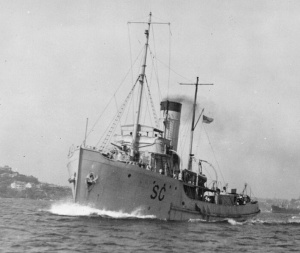HMAS St Giles
| Class |
Saint Class |
|---|---|
| Builder |
Ferguson Brothers Shipyard, Glasgow |
| Launched |
14 May 1919 |
| Commissioned |
15 January 1940 |
| Decommissioned |
11 March 1946 |
| Dimensions & Displacement | |
| Displacement | 380 tons |
| Length | 135 feet |
| Beam | 29 feet |
| Draught | 13 feet |
| Performance | |
| Speed | 11 knots |
| Armament | |
| Guns |
|
| Other Armament | 25 depth charges |
St Giles was a 423 ton tug built for the Royal Navy at Ferguson Brothers Shipyard in Glasgow Scotland, during 1919. She was one of 64 Saint Class tugs ordered by the Royal Navy, of which 46 were built. St Giles was launched on 14 May 1919, and operated by the Royal Navy as a rescue and salvage tug during 1919-1921.
In 1922 she was sold to the Australian shipping firm of J & A Brown, based in Newcastle, NSW. She was subsequently sold in May 1931 to the Waratah Tug & Salvage Co Ltd in Newcastle. On 2 November 1939, St Giles was requisitioned by the RAN for service as an auxiliary anti-submarine vessel. Following conversion at Garden Island Dockyard, she was commissioned as HMAS St Giles on 15 January 1940 under the command of Lieutenant Harold Litchfield, RANR(S).
She was armed with a single 12 pounder quick firing low angle gun, a 20mm Oerlikon anti-aircraft gun, two .303 machine guns and equipped with 25 depth charges. During her RAN service she operated from Port Jackson conducting anti-submarine warfare training, coastal patrols and examination of merchant ships prior to them entering Sydney Harbour. She was decommissioned on 4 May 1942 and, on 18 May 1942, was taken over by the Commonwealth Salvage Board for use as a salvage tug in Australian and New Guinea waters.St Giles was re-commissioned in the RAN on 20 August 1945, under the command of Lieutenant Frederick Pilcher, RANR(S), for use as a target towing vessel and she fulfilled this role until 11 March 1946 when decommissioned and placed in reserve.
St Giles was returned to her owners, the Waratah Tug & Salvage Co Ltd, on 4 June 1947. She was sold to Manners Engineering Ltd. in August 1956 and taken to Hong Kong where she was subsequently broken up for scrap by the Shun Fung Ironworks Ltd during August 1957.



